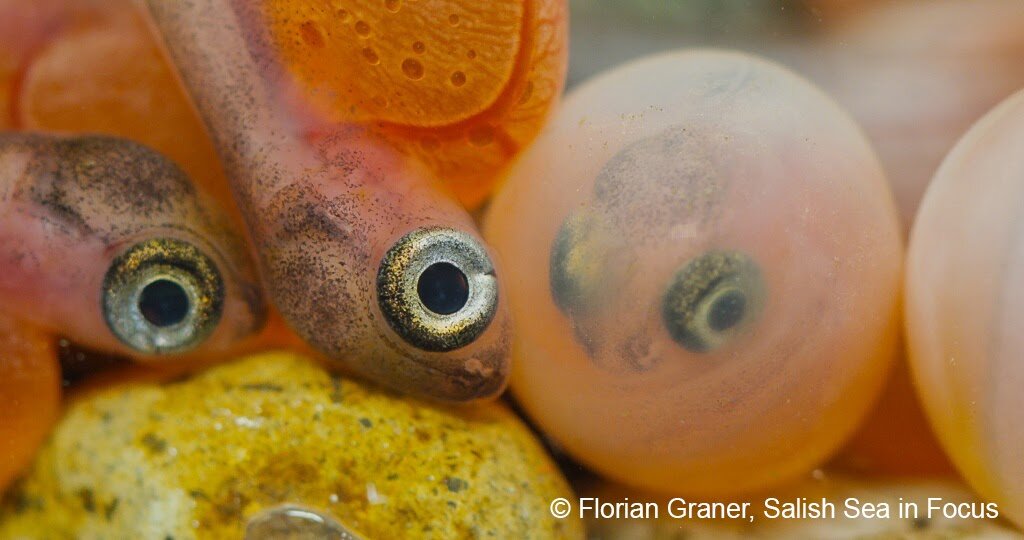Salish Sea Heroes: Our Lady of the Lake Catholic School 4th grade!
Our Lady of the Lake 4th grade students with their newly-planted hemlock seedlings. They will care for these until they are big enough to survive in a salmon restoration site. Note the excellent tree-pose! Photo by Margaret Portelance, teacher and Salish Sea Hero.
Coho salmon just hatched and hatching from eggs in their gravel redd. Salmon need clean, cool, clear water to survive and Our Lady of the Lake students are helping!
Wildlife from trees to bugs to killer whales and you and me need salmon in the great Northwest and salmon need healthy habitat to spawn. Where do they spawn? Cool, clear, clean creeks and rivers. With all the cities, roads, homes, and buildings, there is not a lot of salmon habitat left. But there is hope!
Margaret Portelance’s 4th graders at Our Lady of the Lake Catholic School in north Seattle are working to give streams the 3 Cs (cool, clear, and clean water) they need to be safe for salmon. That means trees! And not just any trees, these kids are planting and raising Washington State’s official trees, the western hemlock, through a program called, “Grow it Forward.”
The people at Grow it Forward supply soil, pots, and seedlings needed so any citizen group or household can plant and grow their own micro nurseries for trees.
Ms. Portelance shares:
"Fourth-grade students at Our Lady of the Lake School in Seattle monitor the water quality of Maple Creek, a tributary of the greater Thornton Creek Watershed, raise coho salmon, and study the effects of stormwater and pollution on the ecosystem.
Growing any plants helps improve habitat for salmon. Plants clean the water that drains into stream. Our Lady of the Lake students plant more than just trees, they plant food, too!
“Nurturing western hemlocks for salmon habitat restoration seemed like a natural addition and an easy way for students to continue to make a positive impact towards protecting the Salish Sea ecosystem.”
Describing the Grow it Forward project, this teacher was all for the trees! “This was a great way to be involved in positively protecting the Salish Sea ecosystem. Hopefully, some of my students may get the chance to plant some of the trees too,” shared Ms. Portelance.
But that’s not all Our Lady of the Lake students do for salmon!
Citizens near their home stream, Maple Creek, formed a coalition to protect this watershed back in the 1950s and these kids are taking it to the next level. They are the first to regularly monitor Maple Creek, to test if the water quality. They also conduct an annual survey of macroinvertebrates. These are little creatures without backbones, like insect larvae, worms, and snails, whose presence or absence tells us if the stream is polluted or clean and on par for salmon survival.
Dragonfly larvae, like this one, are one type of benthic macroinvertabrate that can be found in creeks and ponds in the PNW. Image by Karl Anderson, Flickr Creative Commons.
According to Our Lady of the Lake student scientists, Maple Creek is doing pretty well. But it flows into Thornton Creek before emptying into Lake Washington, all of which are surrounded by the goings on of humans, including culverts that contain water flow under roads, but are often impassable by salmon.
Fortunately, these urban, tree-lined community creeks continue to be protected thanks to Salish Sea Heroes like the residents of Maple Creek, Forterra, the Thornton Creek Alliance, Seattle Public Utilities, and Our Lady of the Lake 4th graders. With all of their actions, maybe one day salmon will spawn all the way up in Maple Creek!
Wouldn’t it be cool to visit a restored salmon stream in 10 or 20 years and see the very trees you nurtured as a child doing their natural job of shading, cooling, and keeping dirt from falling into the salmon stream?
Maybe you’d even see a salmon swimming up to spawn, and know it is partly thanks to you. Now that’s what being a Salish Sea Hero feels like.







